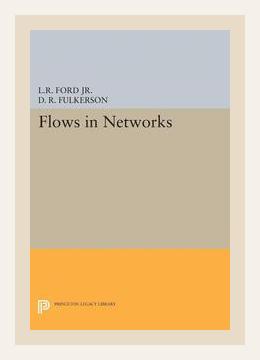Operations and Supply Chain ManagementProcess Improvement
**
Introduction
“Flows in Networks” by L.R. Ford Jr. and D.R. Fulkerson is a seminal work in the field of network theory and process improvement. This book presents foundational methods for analyzing and optimizing flows in various types of networks, which is critical for applications in transportation, communication systems, and logistics.
1. Fundamentals of Network Flow
Key Concept: Flow Networks
A flow network is a directed graph where each edge has a capacity and each edge receives a flow. The book’s main focus is on understanding how to maximize the flow from a source node to a sink node within these constraints.
Example: If you’re managing a water supply system, the pipes (edges) each have a maximum capacity for water (flow), and you need to optimize the water delivery from the reservoir (source) to end-users (sink).
Actionable Step: Identify all nodes and edges in your system, ensuring you clearly define capacities and begin mapping out potential pathways for flow optimization.
2. The Max-Flow Min-Cut Theorem
Key Concept: Max-Flow Min-Cut Theorem
One of the book’s core contributions is the Max-Flow Min-Cut Theorem, which states that the maximum flow through a network from the source to the sink is equal to the total weight of the edges in the smallest cut-set that separates the source and the sink.
Example: In logistics, imagine you’re transporting goods through various routes. The theorem helps identify bottlenecks (cuts) that limit the maximum amount of goods you can transport.
Actionable Step: Apply the Max-Flow Min-Cut Theorem to highlight critical bottlenecks in your system and focus on increasing capacities or finding alternative routes to improve overall flow.
3. Flow Augmentation Paths
Key Concept: Augmenting Path Algorithm (Ford-Fulkerson Method)
The Ford-Fulkerson method is an algorithm that computes the maximum flow in a flow network. It iteratively searches for augmenting paths (paths from the source to the sink where the flow can be increased) and adjusts the flow until no more augmenting paths are found.
Example: Suppose you’re optimizing the data throughput in a network. By identifying paths that can carry additional data, you can incrementally increase the throughput until the network operates at full capacity.
Actionable Step: Implement the Ford-Fulkerson method in your network by iteratively adjusting paths and flows, ensuring you increase the overall throughput to its maximum potential.
4. Capacity Scaling and Improvement Heuristics
Key Concept: Capacity Scaling
Capacity scaling is a variant of the augmenting path method which works by scaling up the capacities and systematically optimizing flows.
Example: Managing a production line where some machinery can be upgraded to handle higher capacities. Scaling capacities allows for phased improvements without overhauling the entire system at once.
Actionable Step: Begin by tackling larger capacities in your system, and then iteratively move to smaller ones, ensuring you maintain an efficient workflow throughout the scaling process.
5. Minimum Cost Flow Problems
Key Concept: Transportation and Assignment Problems
The book also addresses the minimum cost flow problem, which seeks to find the cheapest way to send a certain amount of flow through the network. This has real-life applications like the transportation problem, where goods must be shipped from suppliers to consumers at the minimum cost.
Example: Distributing products from warehouses to retail outlets while minimizing transportation costs. Each route has a cost, and you must find the optimal distribution strategy.
Actionable Step: Establish cost parameters for each route and use algorithms like the Simplex Method to find the optimal cost-efficient flow through your system.
6. Network Connectivity and Reliability
Key Concept: Connectivity and Redundancy
Connectivity measures ensure that the network remains operational if certain nodes or edges fail. Redundancy can improve a network’s reliability by providing alternative routes.
Example: Ensuring that an internet service provider’s network remains functional even if some connections go down due to maintenance or outages.
Actionable Step: Evaluate your network’s connectivity and implement redundant links where single points of failure are identified, thus improving overall system reliability.
7. Advanced Topics in Network Flow Theory
Key Concept: Multi-Commodity Flow Problems
The text extends basic flow concepts to more complex scenarios where multiple different flows interact within the same network infrastructure. This is referred to as multi-commodity flow.
Example: Managing multiple types of cargo through a transportation network where each cargo type has distinct flow requirements and constraints.
Actionable Step: Use multi-commodity flow approaches to streamline operations such as integrating passenger flows with freight in public transportation systems, balancing priorities according to differing needs.
Conclusion
The book “Flows in Networks” provides a comprehensive examination of techniques and theoretical frameworks for optimizing network flows. Applying the methods outlined can lead to significant improvements in varied domains such as logistics, telecommunications, and operational efficiencies.
-
Identify and Map Networks: Start by identifying all nodes and edges and mapping the network layout to provide a clear visual of how flows are structured.
-
Apply Max-Flow Min-Cut Theorem: Utilize this theorem to find and eliminate critical bottlenecks within your network to enhance maximum flow.
-
Implement Ford-Fulkerson Algorithm: Gradually refine your network’s flow capacities by identifying augmenting paths and adjusting flow iteratively.
-
Use Capacity Scaling: Scale your operations by tackling larger capacity enhancements incrementally to improve throughput effectively.
-
Optimize Costs: Address minimum cost flow problems by determining cost parameters and adopting optimization algorithms to reduce operational expenses.
-
Enhance Reliability through Redundancy: Implement redundant pathways to improve overall system resilience and ensure consistent performance.
-
Manage Multi-Commodity Flows: Develop strategies to handle diverse flow requirements within a single network structure effectively.
Through these methodologies, Ford and Fulkerson’s insights offer enduring relevance and practical utility for any process improvement practitioner focused on optimizing network flows.
